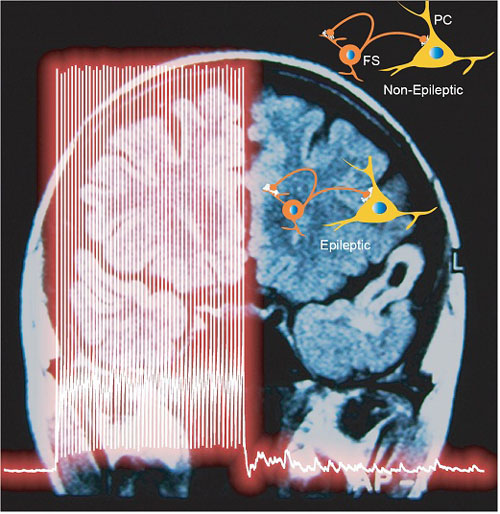Time:2012-05-09
On May 8, 2012, PLoS Biology published online a research article entitled "Enhancement of asynchronous release from fast-spiking interneuron in human and rat epileptic neocortex". This work was carried out by graduate student Man Jiang under the supervision of Dr. Yousheng Shu, in collaboration with Dr. Kaiyan Wang at Shanghai Huashan Hospital of Fudan University and Dr. Hui Guo at Shanghai Quyang Hospital of Tongji University.
A balance between excitation and inhibition is critical for normal brain functions. Disruption of this balance may lead to brain disorders such as epileptic seizures. Down-regulation of GABA inhibition may lead to the hyperexcitability of cortical networks and the generation of epileptiform activities. In this study, the authors have identified new changes in the inhibition system, by showing that asynchronous release (AR) of GABA from output synapses of fast-spiking (FS) interneurons is enhanced (up-regulated) in epileptic cortical tissues.
Neurotransmitter release is normally tightly coupled (synchronized) to the generation of action potentials; however, in response to a burst of action potentials fired at high frequencies, prolonged AR occurs during and after the burst in addition to the synchronous release. To understand the underlying mechanisms of epileptogenesis, previous studies focused on the alteration of synchronous GABA release. However, the changes in AR of GABA could be also important because neurons discharge high-frequency action potentials during epileptiform activity. Man Jiang carried out dual recordings from FS neurons and excitatory pyramidal cells (PCs) in cortical slices obtained from human patients with intractable seizures and model animals with status seizures. He found that AR occurred at all output synapses of FS neurons in both human and rat neocortex, but stronger at FS neuron autapses (self-connection) than synaptic connections from FS neuron to PCs. Importantly, he also discovered that the AR strength was substantially enhanced in the epileptic tissue in comparison with non-epileptic tissue.
The enhanced asynchronous GABA release could be an answer of cortical inhibitory neurons to excessive excitation in the epileptic brain. It may provide stronger inhibition to the cortical network and shape network activities during epileptic seizures. Future studies will focus on identifying molecular mechanisms underlying the AR enhancement and finding ways to treat epileptic patients by reducing the AR strength in autaptic connections but increasing at FS-PC synaptic connections.
This work was supported by the grants from the Chinese Academy of Sciences, the Ministry of Science and Technology, the National Natural Science Foundation of China, the Shanghai Municipal Government and the State Key Laboratory of Neuroscience.

The background is a coronal MRI plane of a patient with intractable epilepsy and glioma at the temporal lobe. The voltage trace shows the firing pattern of a recorded FS neuron. Note the spontaneous postsynaptic events (induced by the asynchronous GABA release) that follow the train of action potentials. The Cartoon indicates the enhancement of AR at output synapses of the FS neuron in epileptic tissue.
 附件下载:
附件下载: